Project Introduction
Farcaster is a decentralized social networking protocol designed to facilitate direct connections between users, while allowing developers to access public data without permission. It supports diverse and flexible client and application development, encourages innovation and experimentation, and provides users with rich social experiences and choices. Farcaster is based on Ethereum and OP for on-chain user identity management, but stores messages and posts in the off-chain Hub network to improve speed and reduce costs. Additionally, Farcaster focuses on providing high-quality and in-depth conversations, attracting developers and Ethereum's co-founder, Vitalik Buterin, as heavy users, forming a strong community culture and values.
Author
JUMPENG, a senior researcher at Shiliantou Research Institute. He holds a master's degree in finance from Huazhong University of Science and Technology, with 7 years of industry experience, specializing in Layer1, DeFi, NFT, Layer2, Gamefi, and has researched over 2000 projects, producing over 500 in-depth research reports.
1. Research Highlights
1.1. Core Investment Logic
As an innovative decentralized social networking protocol, Farcaster's core investment logic is reflected in several aspects:
Strong financial support and excellent technical team experience: Farcaster, as a leading decentralized social protocol, successfully completed a $30 million angel round of financing as early as 2021, led by top VC a16z. More importantly, Ethereum's co-founder, Vitalik Buterin, has publicly praised Farcaster on multiple occasions, explicitly expressing support for its technical approach. Furthermore, Farcaster's core team members are equally experienced, with co-founder Dan Romero having previously held senior positions at Coinbase, bringing rich industry background and resources to Farcaster. Overall, Farcaster's forward-looking technical solutions and business model have been highly recognized by various parties, and the founding team composed of top VCs and industry experts has provided strong support. In the blockchain field, project quality and leadership core often determine its status. Farcaster has demonstrated outstanding performance in these two aspects, which is the fundamental reason why investment institutions have long been paying attention to it, as it has enormous potential for future growth.
Powerful decentralized and migratable social functions: Farcaster, as an open social protocol, allows various applications to be built on top of it. Users can freely choose the app that suits their needs for social interaction. If a particular app fails to meet the user's needs for any reason, they can easily transfer all their social data to another app without any intermediate steps. This cross-app portability greatly enhances the user experience. Additionally, as a decentralized network, all user social data and relationships on Farcaster are publicly distributed and fully controlled by the users themselves, unlike traditional apps that pose a risk of centralizing user assets. Furthermore, Farcaster blurs the differences between apps and connects all applications into an open ecosystem, allowing users to freely choose different social products for seamless interaction. Based on these advantages, Farcaster ensures maximum protection of user data security and usage rights, while allowing developers to innovate on top of it, creating significant business opportunities and value realization space for investors. Overall, Farcaster's decentralized and user-centric design philosophy is the core long-term investment value.
Strong openness conducive to ecosystem construction and application innovation: As an open social protocol, Farcaster supports developers in building various social dApps on top of it. Users can use a unified social account across different apps, reducing the barrier to entry for developers. This will be conducive to the growth of the developer community and ecosystem, and will stimulate more innovation in social products and gameplay. Additionally, Farcaster allows developers to provide various profit models, providing users with a richer interactive experience. In the future, it may also consider optimizing developer incentive mechanisms at the protocol level to further promote ecosystem prosperity and competition. Overall, Farcaster's development as an open protocol provides a more flexible and potential application space for the Web3 social field, which is its advantage for sustainable development.
1.2. Valuation
Considering that Farcaster has not yet implemented token issuance or public financing, there is currently no specific valuation data available for reference. Although it completed a $30 million seed round of financing in July 2022, the specific price conditions are difficult to ascertain, and Farcaster has not issued tokens or disclosed its economic model, lacking a direct reflection of market acceptance in terms of price levels.
At the same time, as a new project, user growth and commercialization processes are still in the early stages, making it difficult to provide accurate financial indicators. However, based on the information currently available to us, a rough estimate can be made:
• The scale of the seed round of financing has exceeded $30 million, indicating high expectations from short-term investors for the project's prospects;
• The user growth trend after the opening in October 2023 looks promising, and the valuation may rapidly increase with future business expansion;
• With further ecosystem development and maturation of the business model, Farcaster's potential will be further unleashed;
Overall, given the gradual accumulation of actual operational data today, we can only provide a macro valuation range for Farcaster based on limited information, and its true value will need to be tracked and verified over the long term.
1.3. Project Risks
The project risks of Farcaster mainly lie in the low user participation, high technical barriers, difficulty in popularization, high initial user retention costs, uncertainty challenges brought by technical and product maturity, and competitive risks. For specific details, please refer to section 5.2 SWOT Analysis in the report.
2. Project Overview
2.1. Project Introduction
Farcaster is a protocol based on Ethereum and the Optimism mainnet, used to build decentralized social applications. Farcaster allows users to create, own, and transfer their identities and content without relying on any centralized platform or service. Its goal is to create an open, free, diverse, and interoperable Web3 social ecosystem. The project was founded by Dan Romero and Varun Srinivasan in Silicon Valley in 2021.
2.2. Team Overview
2.2.1. Overall Situation
The Farcaster Protocol was created by former Coinbase executive Dan Romero and Varun Srinivasan. Dan Romero previously served as Vice President and General Manager of Coinbase, responsible for Coinbase Pro, Coinbase Prime, Coinbase Custody, and other businesses. Varun Srinivasan previously served as Engineering Director at Coinbase, responsible for products such as Coinbase Wallet. Both are seasoned professionals in the blockchain field with rich experience and resources. In addition to the two co-founders, Farcaster also has a team composed of senior engineers, designers, and operations personnel from well-known companies such as Coinbase, Facebook, and Twitter.
2.2.2. Core Members

Dan Romero: Dan Romero is the co-founder of Farcaster and a former Vice President of Operations at Coinbase. He has rich experience in both the cryptocurrency industry and the traditional internet industry. Romero joined Coinbase in 2013 and held key positions within the company, including Vice President of Business Operations and General Manager of Institutional Business. He was involved in the development of Coinbase's business operations and organizational structure, and witnessed the rapid growth of the company's user base. Prior to joining Coinbase, Romero worked at companies such as Zynga and Facebook, accumulating rich experience in consumer internet products and games, providing support for his future development of consumer-grade encrypted applications. It can be seen that Dan Romero, as the co-founder of Farcaster, has deep accumulations in both the cryptocurrency and traditional internet industries, and is an entrepreneur with a broad technical vision and foresight.

Varun Srinivasan: Varun Srinivasan is a co-founder of Farcaster, with rich work experience in software development and hardware design. Srinivasan was previously responsible for platform product development at Coinbase, participating in the design of the core trading system for the cryptocurrency exchange, providing him with valuable experience in developing cryptocurrency products. Prior to that, Srinivasan held a position at SoundFocus, a startup supported by the incubator Y Combinator, where he was responsible for audio hardware design, gaining experience in consumer electronics product development. Additionally, Srinivasan has also worked at Microsoft, participating in the development of productivity software tools, providing him with the opportunity to design products in a large company environment.
2.3. Financing Situation
On July 13, 2022, according to an official announcement, the decentralized social protocol Farcaster completed a $30 million financing round, led by a16z, with participation from Standard Crypto, Elad Gil, 1confirmation, Scalar Capital, First Round Capital, Volt Capital, A Capital, Todd and Rahul's Angel Fund, Coinbase Ventures, Mischief, Ansa Capital, Haystack, Ribbit Capital, Chapter One, Multicoin Capital, Offline Ventures, Archetype, Canonical Crypto, Proof Group, Floodgate, Balaji Srinivsasan, 6529, Ray Tonsing, and others.
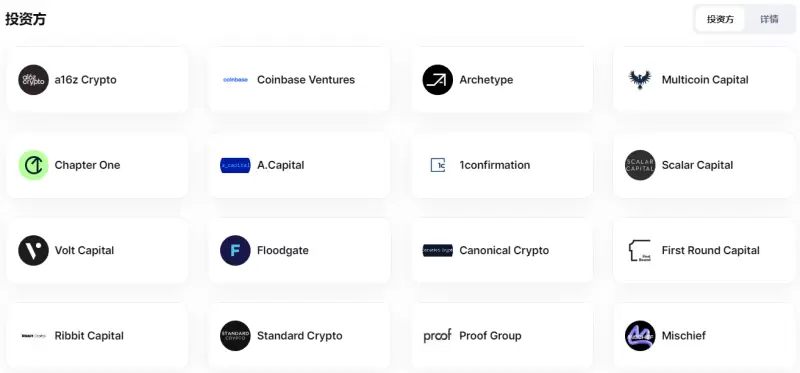
2.4. Past Development and Roadmap
2.4.1. Past Development
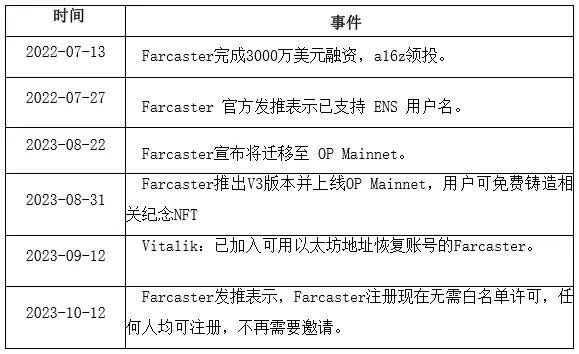
2.4.2. Development Plans and Roadmap
Farcaster has not yet published a clear development plan or roadmap, but based on its official documents and social media, we can speculate on some possible development directions:
• Launching the native token FC and designing its token economic model and governance mechanism
• Supporting more on-chain functions and services, such as NFTs, DeFi, DAOs, etc.
• Supporting more off-chain functions and services, such as search, indexing, data analysis, etc.
• Supporting more client and application development, providing more tools and documentation
• Expanding the scale and diversity of users and developers, increasing community activity and cohesion
• Enhancing cooperation and interoperability with other Web3 projects and platforms, creating a more open and inclusive ecosystem
2.5. Social Media Data
As of October 17, 2023, Farcaster's performance on social media platforms is average. The main operating channels for the project are Twitter, YouTube, and Telegram. Currently, Farcaster's Twitter account has attracted over 50,000 followers, with frequent updates and interactions, making it one of the most popular promotion channels. Below are the specific data for each platform:

3. Project Analysis
3.1. Project Background
With the rise of decentralized networks, netizens need an open and transparent social platform, rather than being restricted by centralized commercial giants. Currently, Web2 social platforms have shown limitations in stifling innovation and growth ceilings, making decentralization a better choice. The financial system (DeFi) and organizational form (DAO) of Web3 have been widely applied, and decentralized social networking can fill the last piece of the puzzle in the Web3 revolution. The goal of Farcaster is not to simply replicate Web2 platforms, but to use technological innovation to establish a decentralized social network with user data empowerment and platform openness. The background of Farcaster is the advocacy of freedom and openness in Web3 thinking, representing the inevitable trend of the development of internet social platforms, laying the foundation for fair and open social interaction. Specifically, the main background of Farcaster includes the following aspects:
Issues with Web2 social platforms: Web2 social platforms are controlled and operated by centralized companies or organizations, giving them absolute power and control over user identities and content. This has led to many issues such as unfair profit distribution (users' created value is not fairly shared), data lockdown (users find it difficult to switch platforms, leading to fragmented identities and experiences), and closed ecosystems (hindering new innovations and limiting developer participation).
Demand for Web3 social protocols: With the rise of Web3, more and more users and developers are exploring decentralized social networks, seeking a more free, open, private, and secure way of social interaction. There are three main aspects of value seeking: 1) achieving true ownership of assets and ownership, users can share platform appreciation through the issuance of cryptocurrencies. 2) Providing an open and interoperable identity recognition system, public and private keys can safeguard data sovereignty, achieving cross-platform interoperability. 3) Building a scalable ecosystem. Leveraging the open architecture on-chain to achieve the interoperability of dApps.
Challenges of Web3 social applications: Web3 social applications are client or interface developments based on Web3 social protocols, allowing users to use Web3 social functions in a more user-friendly and convenient manner. However, current Web3 social applications still face some challenges, such as user experience, performance, cost, compatibility, etc.
Farcaster aims to address these issues by providing a simple, efficient, flexible, and scalable Web3 social protocol, and promoting the development and prosperity of Web3 social applications.
3.2. Project Technical Architecture
Farcaster is based on the principle of "sufficient decentralization," which means that the protocol is decentralized enough to achieve its goals, but not to the extent that it affects its usability or efficiency. Based on this principle, Farcaster achieves this through a hybrid architecture with on-chain and off-chain components: on-chain identity management and off-chain content storage.
1) The on-chain system is based on the Ethereum and Optimism mainnets, primarily providing smart contracts and managing user identity IDs;
2) The off-chain system is based on hub nodes, which are servers that store and distribute user-generated content based on a P2P network;
3) Client applications: Different apps built by developers connect to the hub to retrieve data;
In other words, the Farcaster protocol consists of two key components: one is the on-chain registration, where users can apply for a unique username, and their user identity is recorded and owned on-chain, and the other is the off-chain servers or hosts, where users store their social data, i.e., messages and posts are stored in the off-chain node network known as the Hub.
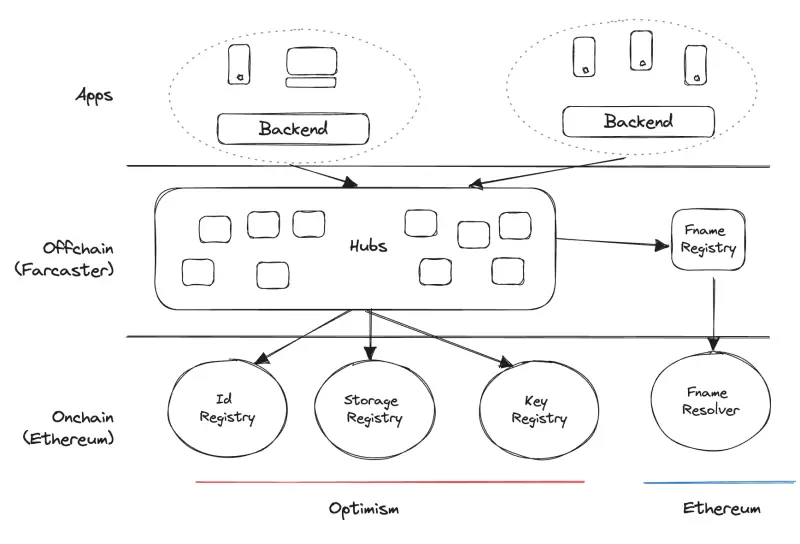
Source: Project DOCS
By analyzing the technical architecture of Farcaster v3, it can be seen that Farcaster adopts a modular design: there are many off-chain modules, including various social applications and communities, which greatly reduces the user's usage threshold and cost, while the on-chain modules are extremely streamlined, with only user identity and storage contracts on-chain. This can reduce the cost of development and usage, as well as reduce on-chain data redundancy. Users only need to perform necessary on-chain interactions, while other tasks can be completed off-chain. In addition, Farcaster itself, as a decentralized channel hub connecting off-chain social applications with on-chain basic services, also achieves another level of modularity, making the protocol more lightweight, reducing costs, and greatly improving the user experience.
Specifically, Farcaster's network architecture consists of the following three main parts:
1) Identity Management System
Farcaster has three main contracts deployed on the Optimism mainnet to manage account identities, signers, and storage. They are:
• Id Registry: This contract issues Farcaster accounts to Ethereum addresses, with each account having a unique numerical identifier called Farcaster ID or fid. An address can only have one fid at a time, but they can be freely transferred. Accounts can specify a recovery address and transfer fids at any time.
• Storage Registry: It leases storage units to accounts, charging an annual rental fee. Accounts must hold storage to publish messages on Farcaster. Storage prices are denominated in USD but paid in ETH, with real-time exchange rates obtained through Chainlink from exchanges. Farcaster adjusts prices, unit sizes, and other parameters based on supply and demand.
• Key Registry: This contract allows accounts to register a signer who can sign messages on their behalf. Signers can be added or removed at any time, but once removed, they cannot be added back. A signer can be added to multiple accounts. Signers are Ed25519 public keys and must be accompanied by the requester's signature. The requester is the account requesting the key, which can be the user's account or the account of an application acting on behalf of the user.
2) Hubs
Farcaster achieves real-time data synchronization and dissemination through Hub nodes. Hub nodes are servers responsible for verifying, storing, and replicating messages created by each account on the Farcaster network. Applications can achieve real-time read-write interaction with Farcaster by running Hub nodes. Additionally, Hubs operate on a eventually consistent model, meaning the order of data dissemination may be uncertain, but it is fast. Hubs also maintain complete state data generated by each account in the entire network, while being constrained by the maximum storage unit limit set by the storage contract, ensuring manageable state data scale. Most applications will replicate Hub data to a database for easy indexing and querying. Through the Hub network, Farcaster achieves efficient, real-time data synchronization between nodes, reflecting its flexible technical design philosophy. Additionally, Hub nodes provide a unified data access interface for applications, effectively addressing the conflicting demands of protocol openness and application customization: each application can be independently developed and operated, customizing interfaces and features based on its own needs, ensuring innovation and diversity among applications, making it possible to create an application ecosystem within the Farcaster protocol.
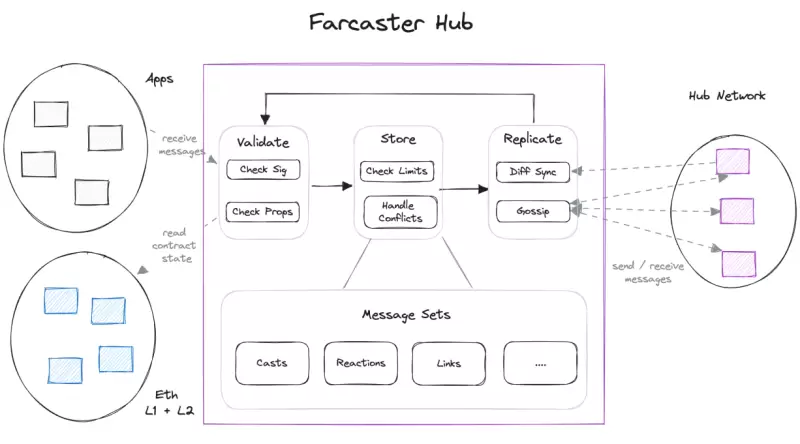
Source: Project DOCS
3) Usernames
Users can use ENS names to give their accounts an alias, making it easier for others to mention them in messages. Names must be short and can only use lowercase letters, numbers, or hyphens to prevent impersonation using similar characters.
Farcaster currently supports two types of ENS names:
• fnames, which are names provided for free by Farcaster to users.
• .eth names, which are names registered and controlled by users at their own expense.
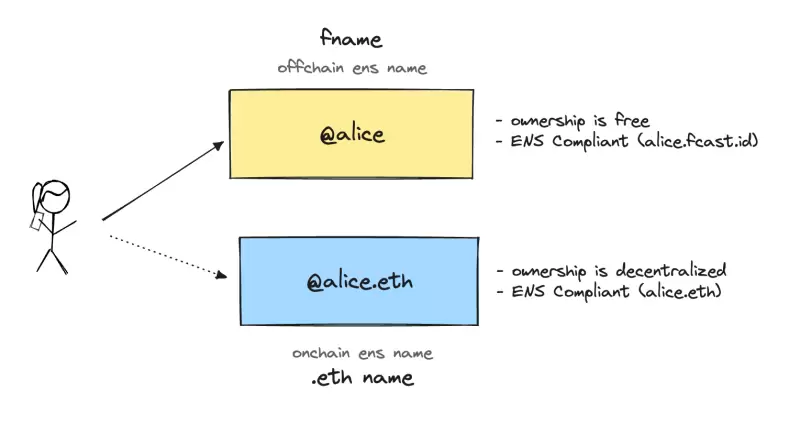
Source: Project DOCS
3.3. Project Principles
After understanding Farcater's network architecture and related concepts, let's briefly explain the working principles of Farcater. The technical principles of Farcaster can be summarized into four parts:
1) User Identity Management
Farcaster uses smart contracts on the Ethereum and Optimism chains to manage user digital identities. A user's identity is an account based on a smart contract, consisting of a unique numerical ID and an optional human-readable name (fname). It can be created and renewed by paying a certain amount of ETH and can be transferred or destroyed at any time. Additionally, a user's identity can register multiple signers to represent the user in publishing content or performing operations, ensuring the accuracy and verifiability of user identity information.
2) Content Distribution Mechanism
Various social content generated by users (any information signed by a signer and published on Farcaster) is not stored on-chain but is stored on Hub nodes in the Farcaster network. These Hub nodes are interconnected using a P2P network topology and rely on a decentralized dissemination protocol to efficiently distribute content between nodes, significantly reducing the cost of content distribution. User content can be commented on, reacted to, or followed by other users, and can be indexed or searched.
3) Data Storage Method
As a distributed storage node, the Hub is responsible for storing and disseminating user content. Anyone can run a Hub and interact with the Storage Registry contract to obtain storage space and income. Each Hub node uses a directed acyclic graph (DAG) as an incremental data structure to store user content, efficiently updating the node's data state. Nodes synchronize network states by propagating incremental data, allowing nodes to quickly join the network and efficiently synchronize the latest data.
4) Client Application Development
Farcaster supports developers in developing various client applications based on the protocol. Different clients can connect to the Hub network to retrieve data and present it to end users in different ways. This provides users with a wide range of application choices and allows developers to fully unleash their creativity.
Through these technical means, Farcaster has achieved an open, secure, and efficient decentralized social network, reducing operational costs and providing more freedom for users and developers. In summary, based on its whitepaper and technical architecture, Farcaster's goal is to build a foundational social registry that any client can use to create social products. Compared to other platforms with rigid data, Farcaster's open protocol, easy migration, and multi-client design provide users with greater freedom of choice.
3.4. Project Operation Process
After understanding the technical principles of Farcaster, let's briefly introduce the operation process of Farcaster to deepen the understanding of the project. The operation process can be divided into the following steps:
1) Registering Identity: Users need to register their digital identity in Farcaster's smart contracts, which will generate a unique human-readable ID represented by an NFT and link it to a wallet address. Users can use their ID to publish, comment, react, and follow other users. Additionally, Farcaster's ID needs to be renewed annually, and if expired, it can be auctioned.
2) Content Signing, Delivery, Distribution, and Storage: When users are ready to publish content, they sign the content using a private key to generate a signed message. The signed message is then transmitted to Hub nodes in the Farcaster network, where the Hub nodes use the Gossip protocol for fast and efficient content distribution. The content can quickly and efficiently reach all nodes. Upon receiving the content, each Hub node incrementally updates its directed acyclic graph database and stores the content, enabling fast querying and updating.
3) Accessing Content: Client applications developed by developers can connect to the Hub network to retrieve relevant data based on users' digital IDs and present it to end users.
Through this operational process, Farcaster has built a decentralized social network composed of modules and mechanisms such as digital identity, content signing, Hub propagation, and client querying, allowing users to enjoy an open social experience while maintaining control over their data.
3.5. Project Ecosystem
Farcaster has attracted many core users from the early stages, including VC professionals, project founders, and mainstream figures in the Ethereum community. Since opening registration on October 10th, Farcaster has experienced rapid user growth, reaching nearly 200,000 users. Additionally, according to the official website, the ecosystem has seen the establishment of over 30 different types of applications built on the Farcaster protocol. The ecosystem applications are diverse, mainly categorized into client and non-client types. Most ecosystem members are expanding applications based on the official Farcaster client, Warpcast. This indicates that since its inception, the Farcaster ecosystem has rapidly accumulated a core user base and application ecosystem scale. With its open architecture, it is expected to attract more developers to co-build an open social ecosystem. Farcaster is poised to become an important platform for social implementation in the Web3.0 field.
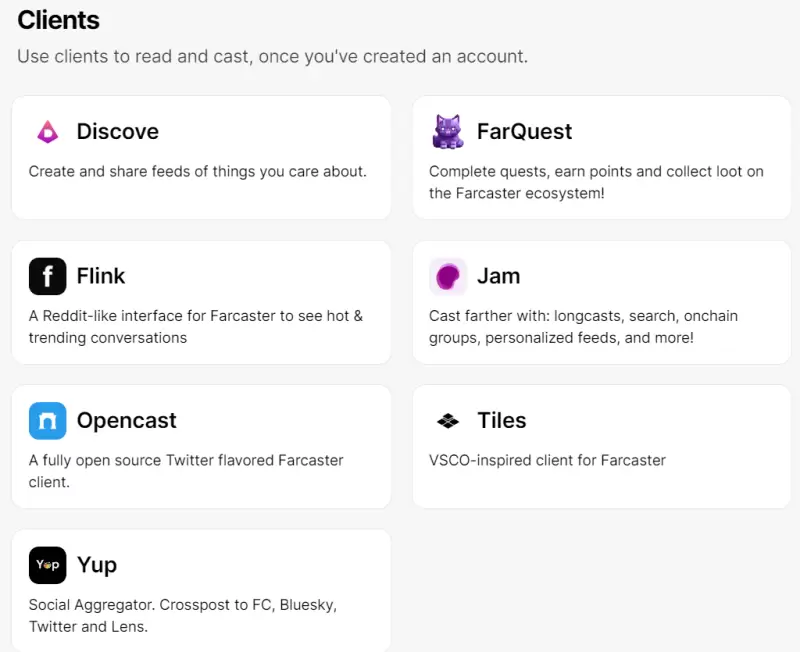
Source: Farcaster Official Website
Let's briefly introduce some of the main products.
1) Warpcast
Warpcast is an application built on the decentralized social protocol of Farcaster, combining the ease of use of traditional social applications with the encryption features of blockchain applications. It is the official client of Farcaster. Warpcast is a client product developed by the Farcaster team and is the most comprehensive and mature tool in the ecosystem. Its user interface and functionality are very similar to Twitter, allowing users to smoothly publish, follow, comment, and interact, reducing the learning and usage costs for users. Additionally, Warpcast leverages Farcaster's digital identity system, giving each user an open digital ID generated on-chain. Furthermore, Warpcast operates completely decentralized, without centralized institutions, and its code and protocol are open-source, enhancing user control over data. This application also supports various on-chain experiences in the encrypted economy, such as token issuance and NFT display. Warpcast plans to achieve community governance through DAO and token forms, actively attracting more developers to build applications and expand the ecosystem of Farcaster and Warpcast.
Warpcast currently dominates over 90% of the market share, which has greatly promoted the flourishing development of the Farcaster ecosystem. While building the decentralized Farcaster protocol, the development team is also committed to iterating and upgrading the Warpcast client. In the long run, the team plans to transfer the daily maintenance of the Farcaster protocol to the open community. Based on the widespread adoption of Warpcast, the Farcaster ecosystem has fully developed, attracting more applications to be built on it, which is beneficial for Farcaster to become a vibrant open social network platform. With community operation at the protocol level, the market position of the Warpcast client will also ensure the sustainable and healthy operation of the Farcaster ecosystem in the long term.
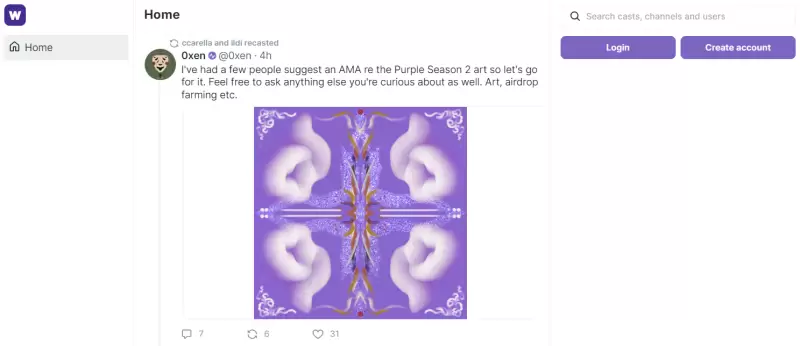
Source: Warpcast Homepage
As the flagship application in the Farcaster ecosystem, Warpcast has an easy-to-use and comprehensive client, which lowers the entry barrier for users to easily access the Farcaster community, undoubtedly a major advantage. However, at the same time, Warpcast's first-mover advantage and significant market share may potentially dampen the enthusiasm and development drive of other applications in the Farcaster ecosystem, which is a potential disadvantage to be mindful of.
Considering that Farcaster is still in the early stages of development, Warpcast is expected to grow into a core leading application to drive the overall ecosystem's development. It may play a role similar to Twitter in the third-party application ecosystem, becoming an indispensable cornerstone application in the Farcaster community.
Overall, while Warpcast has made significant contributions to the Farcaster ecosystem, it needs to avoid excessive centralization and continue to encourage the prosperity of other applications. Only with the simultaneous advancement of the ecosystem can Farcaster achieve long-term sustainable development.
2) Yup
Yup is a social aggregation application that greatly simplifies the user experience of cross-platform publishing and interaction. Yup integrates Lens, Twitter, Farcaster, Bluesky, and other mainstream social platforms through a unified interface. Users only need to publish once in Yup to have their content seamlessly pushed to all associated accounts, greatly improving user publishing efficiency. Additionally, Yup aggregates dynamic information from different platforms, allowing users to view social dynamics from multiple platforms in Yup without the need to repeatedly log in to each application. This provides users with unprecedented convenience - managing global social platforms comprehensively using just one application.
3) Eventcaster
This is an event and activity management tool built on the Farcaster protocol. Users can easily organize online and offline events, publish event information, manage check-ins, and tickets, among other features.
4) Searchaster
This is a content search tool that allows users to quickly search for and access user-related topics, trends, and content within the Farcaster network, providing users with a new dimension of data experience.
5) Paragraph
This project automatically aggregates content from the Farcaster network and integrates it into its own Web3 content publishing platform. The visual editing and publishing experience further lowers the user threshold, providing users with a richer content experience.
6) Unlone
Unlone captures real-time textual dynamics of users in Farcaster and automatically publishes them as themed articles or products, creating more exposure for this content.
7) Discove
Discove is a development toolkit that makes it easier for developers to create mini-programs in the Farcaster client Warpcast, enriching the functionality of the client.
It is evident that the Farcaster ecosystem has begun to take shape. These applications provide more usage scenarios for the Farcaster protocol and offer developers opportunities to showcase their creativity, which will contribute to the prosperity of the Farcaster community.
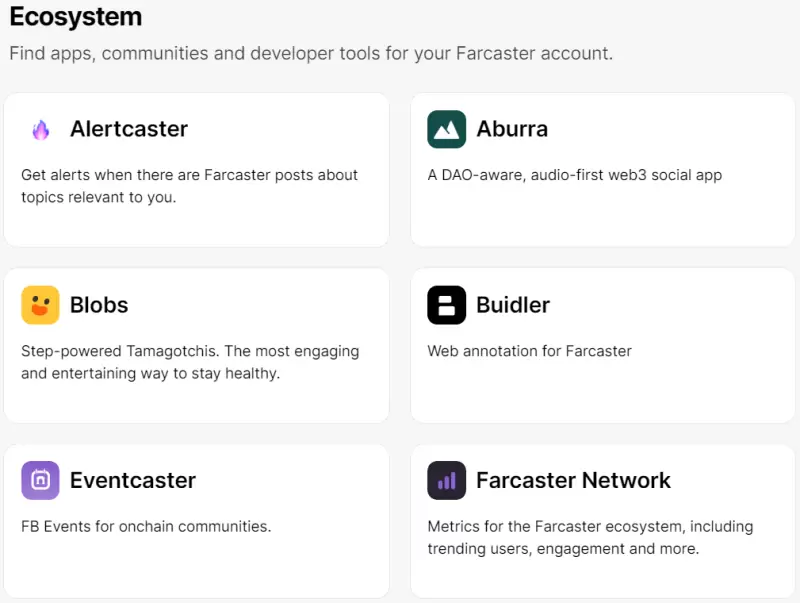
Source: Farcaster Official Website
3.6. Project Data
According to the latest data provided by Dune, the current number of registered users on Farcaster has grown to 189,279. Since opening registration to the public on October 10, 2023, the user base has experienced rapid growth, indicating widespread social acceptance of Farcaster. The data also shows that the current monthly usage fee for Hub storage per user on Farcaster is $1. Currently, the income generated from the rental of storage resources in the Farcaster ecosystem is approximately $25,251 per month. This represents a significant level of usage and activity in the decentralized storage network of Farcaster, and the potential commercial value is expected to increase with the growth of the user base. The above data reflects that Farcaster has successfully attracted a large number of users to participate and actively use the platform, and the future development prospects are promising.
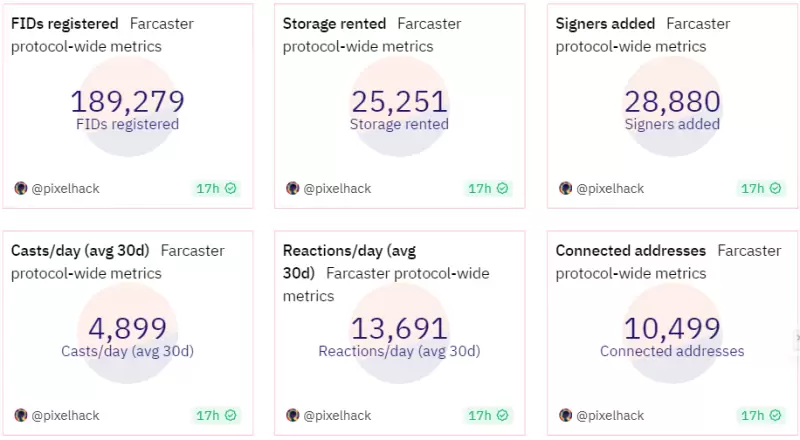
Source: Dune
According to other data on the website, in the past 7 days, Vitalik Buterin (vitalit.eth) ranks second on the most popular list of Farcaster. Additionally, on the list of the most popular channels in the Warpcast client in the past 7 days, channels closely related to the Farcaster ecosystem, such as "farcaster," "memes," and "gm," rank in the top three. Furthermore, the data also shows that the total number of posts on the Farcaster network has exceeded 1 million, indicating a significant amount of content, and the number of posts on some popular community topics has reached tens of thousands, reflecting the continuous increase in community activity. Through the analysis of the above data, it is clear that some mainstream accounts and communities within the Farcaster ecosystem have begun to take shape, and both content production and user engagement are showing positive momentum. The future growth of the Farcaster ecosystem is expected to continue, and its influence and potential commercial value are still worth anticipating.
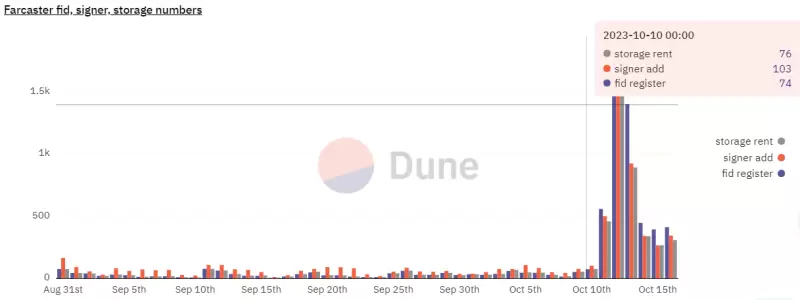
Source: Dune
4. Market Space and Potential
4.1. Track Overview
4.1.1. Track Positioning
Farcaster belongs to the Socialfi track and is further subdivided into a middleware project, providing a protocol layer for Web3 social applications. Middleware projects use existing public chain infrastructure to build protocols, providing services for application developers to query, organize, and display data, aiming to lower the barriers to Web3 social application development and promote more innovation and experimentation in the space. Middleware projects mainly face the trade-off between user experience and protocol generality. Depending on their target users and use cases, each major social application may have different logic behind their data structure and interface. A middleware project with a vision to create a protocol-based ecosystem may have to provide more flexibility at the protocol level and more specificity at the product level.
4.1.2. Track Scale
The market size of Web3 social applications can be estimated by looking at the market size of Web2 social applications and the potential market share that Web3 social applications can occupy. From the perspective of the Web2 market, the user base of global mainstream social media platforms ranges from hundreds of millions to billions, indicating a vast market space. Currently, over 4.65 billion people globally use social media, equivalent to 58.7% of the total global population. Social media companies in the Web2 space provide an easy way for people to connect with friends and family and access a large user base, resulting in remarkable profits. For example, the global leader in social media, Meta, has a user base of nearly 3 billion, with a revenue of $116.09 billion in 2022 and a net profit margin of approximately 19.89%.
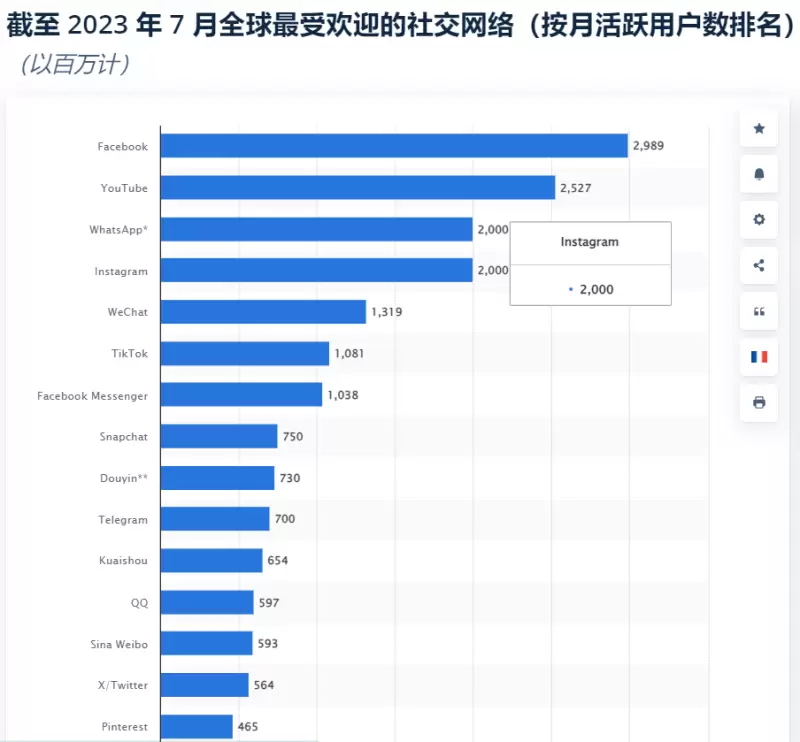
Source: https://www.statista.com/statistics/272014/global-social-networks-ranked-by-number-of-users/
In contrast, the Web3 social space is in its early stages, with a relatively low user base and level of commercialization. For example, the middleware protocol Lens Protocol has approximately 100,000 registered users, and Farcaster, in its current stage, has experienced rapid user growth but still has no more than 200,000 active users.
4.1.3. Track Landscape
Participants in the Web3 social space can be roughly divided into the following three categories:
1) Public Chain Teams (Data Infrastructure)
Most Web3 social applications are built on public Layer 1 (L1) chains such as Ethereum, but there are also notable attempts to provide customized infrastructure to meet the needs of social applications. Compared to other dApps, social applications require faster transaction speeds, greater bandwidth, and cheaper media storage, which may be difficult to achieve on a general-purpose L1 chain. Therefore, some social-specific L1 chains have stood out for their high transaction speeds and cost-effective on-chain storage. These participants leverage the underlying blockchain technology of public chains to build solutions for social scenarios. Representative projects include DeSo, which is positioned as an L1 public chain serving social media, and Crossbell, which serves as an Ethereum sidechain providing shared content storage services. These participants are able to design underlying infrastructure highly customized to the needs of social applications.
2) Middleware (Protocol Layer)
These participants, based on existing public chains such as Ethereum and Polygon, provide solutions for social scenarios by developing blockchain protocols and applications. Typical representatives include Lens Protocol and Farcaster, which we will discuss in detail in the competitive analysis section. These participants can leverage the security and active ecosystem of public chains and focus more on innovation in social scenarios.
3) Traditional Social Platforms (Application Layer)
Existing centralized social platforms such as Twitter and Facebook are also closely monitoring blockchain technology and seeking possibilities for integration. For example, Twitter has launched the decentralized social project Bluesky, Telegram has added a governance and economic system to its platform through the TON chain, and Reddit has added an economic system to its platform by issuing community tokens on Ethereum. These traditional platforms are participating in Web3, partly due to insights into future technological trends and partly to respond to potential Web3 social competitors in the market. Additionally, representatives at the application layer include Web2 social application mini-program ecosystems like MASK, which will not be detailed here.
The above three main participants constitute the current competitive landscape of the Web3 social space. Each party enters the space from different perspectives: public chain teams provide infrastructure, middleware teams build protocols and applications, and traditional platforms seek breakthroughs. This heterogeneous competitive landscape also provides diversity and vitality to the Web3 social space.
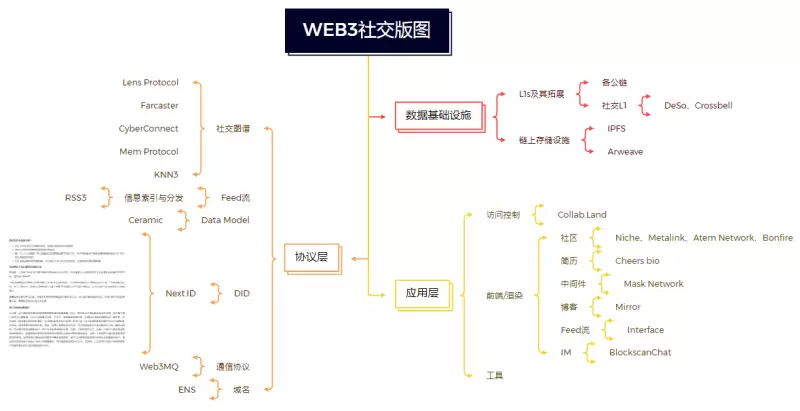
4.2. Competitive Analysis
4.2.1. Core Competitive Factors
The core competitive factors between current social protocols mainly manifest in the following aspects:
1) Decentralization Level: Decentralization is a core feature that distinguishes Web3 from Web2. In comparison to traditional centralized social platforms, the degree to which Web3 social products achieve decentralization is a key competitive dimension. Key points for evaluating the level of decentralization include information storage methods, network deployment modes, and decision-making governance mechanisms.
2) User Experience: Regardless of centralization or decentralization, user experience directly impacts the usability and attractiveness of a product. For Web3 social products, achieving a decentralized approach while maintaining a simple and seamless user experience is crucial. Key considerations include interaction processes, page loading speed, and gas fees.
3) Ecosystem Development: A healthy ecosystem can continuously provide new user groups and application scenarios for Web3 social products. It is crucial to attract developers to build more social dApps. Dimensions for evaluating ecosystem development include protocol developer friendliness, completeness of technical documentation, ecosystem scale, and activity.
4) Technical Development Capability: Blockchain technology itself has certain barriers, and Web3 social products require breakthrough technological innovations and a deep understanding of technological directions in the social domain. Key points for evaluating technical strength include core algorithm, on-chain/off-chain architecture design, and multi-chain support.
5) Community Reputation: Having an active community and a good reputation is an important advantage for Web3 social products. A positive community can provide traffic support and contribute to ecosystem development. Community reputation can be evaluated based on community activity, user sentiment, and public influence.
The above are the core competitive dimensions for evaluating Web3 social projects. These factors, when considered comprehensively, are of significant reference value for assessing a product's market competitiveness. We will conduct a competitive analysis of Farcaster based on these 5 dimensions and in conjunction with examples of middleware protocol layers, taking into account the current track landscape.
4.2.2. Competitive Projects
Based on the classification of the track landscape in the previous section, we will introduce three other well-known social middleware protocols in this section to serve as a competitive analysis for Farcaster. Although they all aim to build a better social application system, they each take different approaches, and the table below captures the differences in their technical architectures.
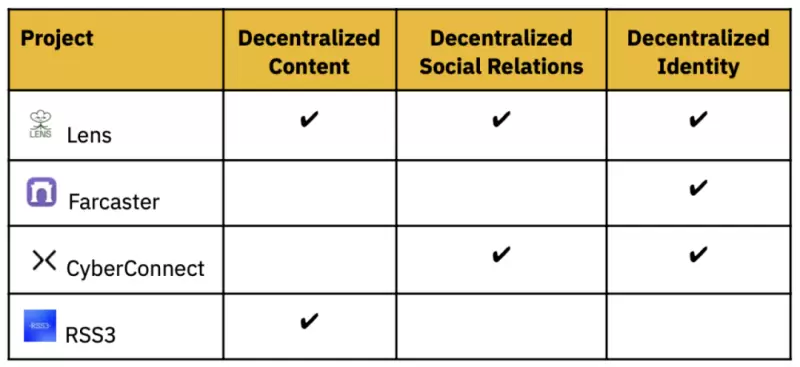
1) Lens Protocol
Lens Protocol is a decentralized social protocol based on Polygon developed by the Aave team. It tokenizes user profiles, posts, and followers as NFTs, creating an on-chain social graph. This allows Lens Protocol to interact with the Ethereum ecosystem and provides blockchain-specific composability and financialization features. Additionally, Lens Protocol offers a flexible SDK to support developers in building various applications on top of it. Lens Protocol currently has over 60 applications and over 100,000 handle holders, but it also faces challenges in scalability and user experience.
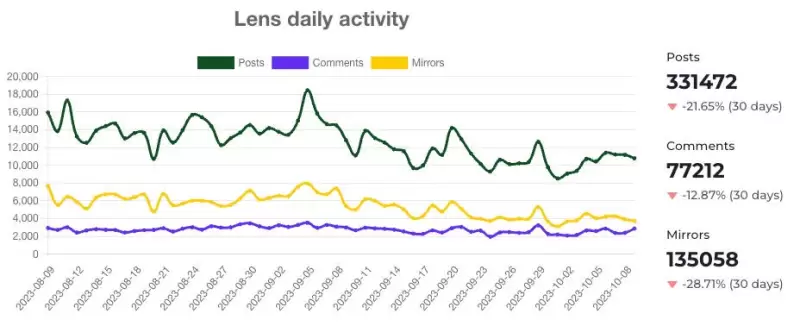
Source: Zurf.social
Lens Protocol is currently in a closed testing phase, with the core team still controlling most of the development process. The testing environment is gradually being opened to the community, aiming to incorporate community suggestions under the EIP governance model to improve the product. At the same time, the Lens team has always emphasized the participation of developers and creators, committed to promoting DApps and service supply on the platform. Content on Lens mainly comes from spontaneous creation and communication by ordinary users or Web3 practitioners, which is in stark contrast to the developer-led intensive community of Farcaster.
Overall, Lens adopts a cautious open testing strategy, gradually leveraging community strength to further optimize the product. In comparison, Farcaster emphasizes developer-intensive community building, which is conducive to rapidly improving ecosystem maturity, but lacks the experimental open attitude to user feedback that Lens has. Both parties have their advantages and disadvantages in ecosystem development routes and methods, which are worth learning from for various Web3 projects.
2) Farcaster
The previous content has provided a detailed introduction to Farcaster, so we will not elaborate further here, but only make a simple comparison. Compared to Lens, which emphasizes technology, Farcaster focuses on user-first, providing greater room for development. Farcaster's design is pragmatic and conservative, not offering too many on-chain features, but instead focusing on creating a set of traditional social media functions, such as posting and commenting. Farcaster's strengths lie in its simplicity, developer friendliness, and closely-knit community atmosphere, while its drawbacks include its partially off-chain and conservative protocol design, which may hinder innovation and ecosystem development, as well as its current inability to collect and trade users' social assets.
3) CyberConnect
CyberConnect is an important social graph protocol aimed at providing unified data support for Web3 social applications. CyberConnect's strength lies in its ability to centrally store social data from different applications in a public database, enabling seamless interoperability between applications. CyberConnect is also incubating its own consumer applications, such as link 3, which is a Web3 version of Linktree with integrated event planning functionality. CyberConnect currently has an ecosystem consisting of 2870 projects, covering various areas including social media, DID, communication protocols, and community management. According to the latest data, CyberConnect already has 2 million registered users and 150 million API calls.
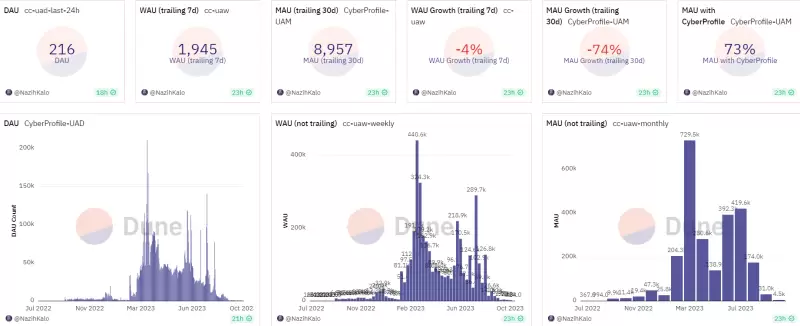
Source: Dune
4) RSS3
RSS3 is a Web3 protocol dedicated to reviving the spirit of the Web1 standard RSS, aggregating on-chain and off-chain content in a decentralized manner.
RSS originally supported server-independent subscriptions but was replaced by Web2 platforms. RSS3 utilizes its distributed nature to re-establish an efficient information distribution channel, focusing on data API queries for all content-related data on Web3, providing end-to-end support for developers. RSS3 integrates the power of distributed computing to reshape the aggregation and dissemination of web information. As a content distribution standard, RSS3 will help Web3 unleash an efficient content ecosystem. Currently, RSS3's main product is its data API, which queries all content-related data on Web3 and returns it to developers. The number of requests per month has already exceeded 200 million.
5) Summary
Based on scale and valuation, social middleware is one of the most influential projects in the Web3 social space. The reason is simple: it may be the most network-effect-driven industry sector. Without isolated social data to lock in users, applications must constantly compete for user attention, and protocols, as tools for developers, have higher migration costs. However, without applications, the protocol itself is useless. For example, projects like CyberConnect and RSS3 have a large number of API calls, but they still cannot turn this developer activity into consumer adoption. Therefore, all the mentioned protocols are actively nurturing application ecosystems, and most protocols are building applications themselves.
In summary, social middleware has a natural advantage in attracting developers, but the consumer side depends on application support. Therefore, the interaction between middleware and applications is key to the development of the Web3 social ecosystem. Both need to work together to build a complete ecosystem.
4.2.3. Competitive Advantages
Based on the comparison of the above competitive projects according to the core competitive factors, we can find that Farcaster's competitive advantages mainly lie in the following aspects:
1) Moderate Decentralization Level
1) Farcaster has achieved a moderate level of decentralization through its on-chain identity system. It uses users' on-chain identities to establish peer-to-peer connections, avoiding reliance on centralized servers. In comparison to fully decentralized solutions, Farcaster makes the product easier to use and reduces implementation complexity. This moderate decentralization ensures user data sovereignty while also ensuring a better user experience.
2) Optimized User Experience
Farcaster stores primary social content on off-chain servers, avoiding frequent on-chain interactions and gas fees. This combined on-chain/off-chain design optimizes the user experience, making Farcaster fast, smooth, and more aligned with the functional habits of mainstream social products.
3) Strong Technical Capability
Farcaster is developed by a seasoned technical team with deep expertise in on-chain/off-chain architecture design and underlying blockchain technology, laying a solid technical foundation for Farcaster. Farcaster is able to achieve the core technological capabilities required for its envisioned product.
4) First-Mover Advantage
Farcaster is one of the early social applications and has undergone product validation and market testing. This first-mover advantage has allowed Farcaster to gather valuable user feedback and establish influence in the field, which is difficult for latecomers to replicate.
5) Positive Community Reputation
Farcaster has a natural advantage in community quality and influence: 1) It has gained wide recognition in the Web3 social field, accumulating a good reputation and credibility; 2) The involvement of Vitalik Buterin not only enhances brand awareness but also brings in a large amount of traffic and users; 3) A thriving community provides strong ecosystem support, facilitating product dissemination; 4) A solid community position injects long-term motivation into Farcaster's ecosystem development and user operations; 5) Good community quality and influence will continue to enhance Farcaster's core competitiveness, positioning it favorably in the Web3 social field. Therefore, the cohesion of the community will be an important driver for Farcaster to maintain its lead.
6) Expanding Ecosystem
Farcaster-related derivative projects have reached 33, indicating that Farcaster's social protocol has gained recognition from developers, and its ecosystem is steadily growing, laying a solid foundation for Farcaster's future development.
In conclusion, Farcaster has significant advantages in multiple dimensions including technology, product, and community. As a pioneer in Web3 social, Farcaster is poised to become a leading brand in this field.
4.3. Token Economy Model Analysis
Farcaster has not yet disclosed its token economy model.
5. Preliminary Valuation Assessment
To conduct a preliminary assessment of Farcaster's value, we can analyze based on the following questions:
5.1. Core Questions
What stage is the project in its business cycle? Is it in the mature stage or in the early to mid-stage of development?
Farcaster, as a relatively new Web3 social project, is still in the early stages of exploring its business model. Farcaster primarily focuses on product and technological innovation and is currently in the stage of validating product-market fit. Although it has launched social applications for testing, it needs to further expand its user base, collect user feedback, and optimize and improve the product. Additionally, Farcaster's revenue model is still under design. Typically, revenue sources for Web3 social projects include token transaction fees, advertising revenue, and value creator sharing. In the future, Farcaster may experiment with community governance mechanisms and token economic design to form a stable business model. Overall, based on Farcaster's current stage, the formation of a business model will need to go through processes such as product iteration, ecosystem cultivation, and scenario integration, and over time, its commercial direction will become clearer.
What are the main variable factors in the project's operations? Are these factors easy to quantify and measure?
User count and activity: These are important indicators for measuring the value and influence of the Farcaster protocol and are key factors in attracting developers and partners. User count and activity can be quantified and measured through metrics such as registered users, daily active users, and monthly active users.
Number and quality of applications: These are important indicators for measuring the innovation and ecosystem development of the Farcaster protocol and are key factors in improving user experience and satisfaction. The number and quality of applications can be quantified and measured through metrics such as the number of applications, types of applications, application ratings, and application downloads.
Data volume and value: These are important indicators for measuring the efficiency and revenue of the Farcaster protocol and are key factors in improving user data security and portability. Data volume and value can be quantified and measured through metrics such as data storage volume, data transfer volume, data transaction volume, and data transaction value.
What is the project's management and governance approach?
Farcaster's management and governance approach is based on a rough consensus and running code model, which means that changes in Farcaster occur when someone proposes a change, gains support, and runs the code. Depending on the change, different groups need to be convinced, including protocol developers, application developers, and users, and consensus arises from people accepting or rejecting new code. Farcaster does not have a binding voting process, official roles, or anyone's veto power. Farcaster also uses the FIP (Farcaster Improvement Proposal) process to establish consensus on protocol changes, where anyone can write a FIP to propose changes to the protocol's processes, standards, or implementations and discuss them on the forum.
5.2. SWOT Analysis
5.2.1. Project Strengths
The project's strengths are detailed in the Core Investment Logic section.
• Strong funding support and support from an experienced technical team
• Strong openness, conducive to ecosystem construction and application innovation
• Strong decentralized and migratable social functions
5.2.2. Project Weaknesses
Low user engagement: Compared to traditional social products, Farcaster's social graph scale is relatively small, with a core user base limited to cryptocurrency users, and it still has a gap from a large-scale user base. Farcaster's social applications overly mimic the functions and forms of mainstream social products, lacking sufficient differentiation. It needs to increase product iteration efforts and propose more innovative social models to attract users. The product follows past patterns and lacks future definition, making it difficult for users to perceive its true value. Successful projects do not imitate, they define. Defining new things at the beginning may make people feel uneasy, but engagement metrics will follow closely. Overall, Farcaster is relatively weak in terms of user engagement and user stickiness, which may become a bottleneck for its comprehensive rise as a leading social graph protocol. In the future, it needs to continuously optimize and enhance the originality of the product to attract more ordinary users.
High technical barriers, difficult to popularize: Farcaster is a foundational social protocol, different from the applications that ordinary users encounter, making it difficult to attract a large number of ordinary users like social applications. Its user base and value exploration are mainly limited to developers and cryptocurrency enthusiasts. Additionally, it involves technical principles of distributed storage and on-chain/off-chain interactions, which have high barriers and are difficult to attract the attention of ordinary users. Furthermore, Farcaster adopts an off-chain storage solution, requiring the maintenance of data copies through running Hubs nodes, which increases participation costs and adds resistance for users to join the community. Overall, compared to the social applications built on top of it, Farcaster, as a protocol tool hidden in the background, itself is difficult to become a hot topic that triggers "fan economy," fundamentally limiting its business influence and visibility. The Farcaster team needs to consider how to reduce protocol complexity and improve developer usability. It also needs to continue optimizing the off-chain storage solution to reduce centralization risks and focus on achieving the original intention of decentralization.
Building a social graph from scratch incurs high user retention costs in the early stages: Social applications built on top of Farcaster, such as Warpcast, primarily target native cryptocurrency users, making it challenging to attract traditional internet users. These applications need to rebuild the social graph from scratch, and currently, the scale and connectivity of Web3 social networks are far from that of Web2. For users unfamiliar with cryptocurrency technology, it takes time to adapt to and accept the decentralized mode of social applications. In today's environment where the Web3 concept is not widely accepted, the initial lack of sufficient social volume and ecosystem support makes it costly to provide users with a comprehensive experience, posing challenges to user engagement and stickiness. At the same time, compared to applications directly utilizing Web2 platform traffic, such as Friend.tech, Farcaster lacks strong alliances with Web2 channels, making it difficult to achieve rapid user migration.
However, in the long run, as a protocol-level solution, Farcaster has greater application potential and needs continuous accumulation. Farcaster's applications can consider appropriate interoperability with Web2 platforms to reduce the difficulty of acquiring users. In summary, these can be seen as short-term disadvantages that Farcaster faces at the application level, but this does not mean that Farcaster has no prospects; it still needs time for gradual improvement.
5.2.3. Project Opportunities
Blockchain-based social networking presents a blue ocean market opportunity with vast potential for future development. Traditional centralized social platforms face many issues such as data privacy and content censorship, making blockchain-based social solutions in high demand. Additionally, the current user base for blockchain-based social networking is still in its early stages, but with the widespread adoption of blockchain and cryptocurrencies, the user base is expected to grow rapidly. This makes it an opportune time to enter the blockchain-based social networking space. Furthermore, blockchain-based social networking can achieve deep integration and innovation with other blockchain scenarios such as the metaverse and token economies, opening up more possibilities for business models and user experiences. As a pioneer in blockchain-based social networking, Farcaster has successfully validated its product and gained industry recognition. It possesses technological and community advantages, positioning it as a leader in this blue ocean market. Its funding progress and community influence also attest to this. Farcaster is poised to capitalize on the rapid growth of blockchain-based social networking and become a benchmark project in this field.
As a native cryptocurrency social protocol, Farcaster can serve as an important bridge and springboard for users transitioning from the traditional internet to the crypto world. Farcaster supports developers in building a variety of social applications, which can present concepts and projects in the crypto world in a more open and entertaining manner, such as showcasing NFTs, to attract more users. Furthermore, Farcaster unifies user digital identities, allowing users to freely navigate and experience the crypto world, providing them with the possibility to explore and experience the crypto world. Additionally, Farcaster has fostered a community atmosphere of close interaction between developers and users, which can incubate new applications attractive to the crypto community. Looking ahead, as crypto technology matures, the social scenarios supported by Farcaster may form a unique ecosystem that can cater to both crypto natives and a broader base of traditional application users. As the infrastructure for this potential ecosystem, the value of Farcaster will continue to grow. It may become a crucial link connecting different technological divides, leading the entire industry forward, which is a long-term value proposition pursued by investment institutions.
5.2.4. Project Threats
Despite the vast space for blockchain-based social networking, Farcaster also faces challenges from other competitors. Lens Protocol, as a pioneer in the Socialfi field, has already established a certain user base and ecosystem, posing direct competitive pressure on Farcaster as a latecomer. In addition to Lens Protocol, other Socialfi startup teams are also actively positioning themselves, which will undoubtedly dilute users and resources. Furthermore, traditional centralized social platforms may also join the competition in blockchain-based social networking. If successful, the transition of platforms like Twitter and Facebook will have a significant impact on the industry landscape. Finally, breakthroughs in other blockchain areas may also divert attention and capital, such as the metaverse. In summary, the competitive pressure on Farcaster is increasing. To maintain its lead, Farcaster needs to accelerate product iteration, expand its user base, and continuously ensure its differentiation advantage through technological and business model innovation.
Uncertainty challenges brought about by the maturity of technology and products. As a project that has just opened up registration on a large scale, Farcaster has shortcomings in its own technological implementation and product maturity, introducing a certain level of uncertainty. 1) Core technical solutions such as the distributed hub network (Hub) are in the early stage of design, and their stability and scalability need further verification; 2) There are unknowns regarding whether product features can continue to innovate to meet rapidly evolving user needs; 3) The consistency and compatibility of the experience across different terminals are unknown, which may lead to crashes or errors for users; 4) Interoperability with public chains and other ecosystems needs to be optimized to avoid technical compatibility barriers; 5) The ability to repair and prevent security issues still needs long-term refinement and improvement; 6) Differences between the testing environment and the production environment may impact the initial user experience and trust. Once technical instability issues are highlighted, they may bring downward risks to the community impact and valuation. Additionally, Farcaster's product iteration is still in the early stages, and there is uncertainty about whether it can become a product that mainstream users love. Furthermore, Farcaster's ecosystem construction is still in the early stages, requiring more developers to build applications and incubate popular flagship applications, posing a challenge to rapidly acquiring a user base.
Compared to traditional centralized social networking, the network effect of decentralized social networking is indeed weaker. Decentralized social networking emphasizes open data permissions and user sovereignty, reducing user switching costs and making it difficult for individual applications to lock in users. In decentralized social networking, applications can share social graphs, while the social graph in traditional social networking is closed, weakening the network effect of individual applications. Furthermore, based on open standards, decentralized social networking will lead to more homogeneous competition among applications, which also disperses users and does not favor individual applications in gaining exclusive advantages. Finally, there is uncertainty about whether decentralized social networking applications can create sufficient differentiation and attract enough traffic. Overall, the network effect of decentralized social networking is limited, posing a challenge to Farcaster in forming core competitive advantages. Farcaster needs to provide differentiated products on an open basis to stand out in the competition.
5.3. Reflection
5.3.1. Challenges of Web3 Social Networking
Web3 social networking has many promising innovations, such as DeFi, NFTs, DAOs, etc., which provide users with specific utilities that Web2 cannot achieve. At the same time, Web3 social networking also faces many challenges and limitations, such as user experience, data composability, business models, etc., which hinder its widespread adoption and development.
Firstly, the scenarios provided by Web3 social networking that surpass the Web2 experience are still relatively limited. 1) There are too many industry terms (such as wallet, gas, private key, etc.), making the entry barrier high; 2) In terms of ease of use and scalability, Web3 products still need optimization compared to Web2, and the user experience is yet to be improved. 3) Current social interactions are mainly driven by economic incentives and speculation, lacking strong social attributes and not being sufficiently authentic and effective. 4) Address-based social networking cannot identify real users, reducing social efficiency.
Secondly, data unification is challenging. One advantage of Web3 social networking is its data composability, where different protocols can share and utilize data generated by each other, forming an open and collaborative ecosystem. However, there are practical difficulties in the composability of data models from different protocols. Firstly, different protocols define their own data and business metrics based on their own business logic and operational needs, and these data and metrics may be incompatible or inconsistent. Secondly, for an application, it is unrealistic and impractical to capture and use any data model and algorithm created by other protocols. Applications need to design their own data models and algorithms based on their target users and scenarios.
Finally, the business model is uncertain, and decentralized costs are high. The business model for Web3 social networking is still not clear. Web3 social networking needs to find a native business model that is unique from the existing Web2 model. Currently, we have not seen innovation in the business model. Web3 social networking currently relies mainly on token issuance, token sales, token incentives, etc., to generate revenue and increase users. However, these methods cannot sustain the development and operation of Web3 social networking. Web3 social networking needs to find a business model that can balance the interests of users, protocols, developers, investors, and other stakeholders. Web3 social networking should leverage its unique ecosystem in DeFi, NFT, and other verticals to provide users with unique, innovative practical tools, rather than directly competing with Web2 social networking.
5.3.2. Possible Directions for Web3 Social Networking
Currently, the Web3 social networking field has not yet found a breakthrough product (FT has emerged, but its business model is yet to be validated). The main reason is the lack of truly innovative applications that bridge various Web3 scenarios, with most products still in the form of Web2 products and unable to leverage the native advantages of blockchain technology to provide users with unique experiences. Only transformative products that meet actual user needs and integrate the characteristics of various Web3 scenarios can lead the new wave of Web3 social networking.
6. References
- Farcaster project official website: https://www.farcaster.xyz/
- Farcaster official Twitter: https://twitter.com/farcaster_xyz
- Farcaster official documentation: https://docs.farcaster.xyz/
- Farcaster open registration, and differences compared to Lens Protocol: https://www.panewslab.com/zh/articledetails/xxk1cs4l.html
- Binance Research Report: Analysis of the current situation and potential opportunities for Web3 social networking: https://www.panewslab.com/zh/articledetails/rg8k8wzz.html
免责声明:本文章仅代表作者个人观点,不代表本平台的立场和观点。本文章仅供信息分享,不构成对任何人的任何投资建议。用户与作者之间的任何争议,与本平台无关。如网页中刊载的文章或图片涉及侵权,请提供相关的权利证明和身份证明发送邮件到support@aicoin.com,本平台相关工作人员将会进行核查。




